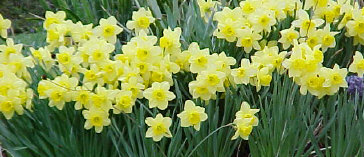Bulbs evolved on the fertile margins of harsh climates, and represent a unique botanical niche in our gardens. The whole group – whether true bulbs, corms, rhizomes, tubers or tuberous roots – evolved a double reproductive system as well as duplicate systems for storage and nutrient uptake. In addition, they have the longest dormant time of any flowering perennial. When we give due consideration to these botanical facts we can easily let them become the easy care perennial stars of our flower garden.
Because bulbs must have a dormant time, and must have their storage organs replenished at the right time of year, right-plant-right-place is essential. Although many are tolerant of a variety of soils and sun needs, we forget that when it comes to their need for certain types of seasonal changes as well as the timing of those changes we doom them to a short-lived existence. We kill off our bulbs by cultivation conditions like too-few days of frost in winter, wet feet at the wrong time of year, or too little sun and heat during their dormant period. Our response? We feed them! In fact, most bulbs need only low levels of fertilizer, and with the naturalizing group usually no extra food at all once established.
So let’s assume we’ve put our bulbs into a spot geared to their seasonal needs. Let’s also assume we are mulching and composting our beds to replenish and feed the soil. Now what? If they are naturalizing bulbs, you may need to do nothing more. That is, if you’ve analysed the soil around them. If you didn’t, those soil test kits from the garden centres work quite well. With a basic N-P-K rating you can now amend the bulb bed or area to feed those extra storage systems and ensure long-lived bulbs.
The best fertilizer for most flowering bulbs has an N-P-K ratio of 4-10-6. This mix should be applied twice a year to young plantings. The first feed is done when the bulb is planted in early autumn, mixed into the soil beneath the planting hole so the tender bulb is not burnt by contacting the amendment. For established bulbs needing food, scratch it into the top of the soil. Rain and composting will let it trickle down to be used by the bulb as needed. Although some sources say it is okay to feed when greenery emerges in spring, the plant is actively growing then. If the soil is still cold and roots did not have enough time to establish before winter, the plant will rely on nutrients in the bulb in addition to its roots and leaves to produce florescence, and so be quite depleted by the end of the season.
The second time to feed is at the end of the blooming cycle. As the foliage dies down, the plant is working hard to replenish its storage organs and clone young replacement bulbs. Feeding now ensures this is completed before the greenery is gone, and the plant goes dormant. It also ensures a healthy bulb that can rely mainly on its roots and leaves during the next growing cycle.
Recommendations for the components of the N-P-K in bulb food have changed in recent years. The old stand-by of a handful of bone meal has been found to be counterproductive. Dr. Linda Chalker-Scott explains her research findings in an article titled The Myth of Beneficial Bone Meal. The article is posted on Dr. Chalker-Scott’s web page at www.theinformedgardener.com.
David Murphy of Welcome Harvest Farms on Texada Island is known internationally for his specialized organic fertilizers. I recently asked Dave for recommendations regarding bulbs. He recommended a 4-10-4 or 4-10-6, as long as the fertilizer has nutrients that enhance good mineral exchange. According to Dave, essential in bulb mixes is langbeinite (a potassium magnesium sulphate mineral), also called K-Mag, as is green sand. Both, he said, have proven essential to onion and potato farmers for many years.
The Tulipa genus is an exception to other bulbs in that it needs fertilizer for its whole life or it declines quickly. I’ve read several experts suggest that tulips benefit from a 9-6-6 ratio. If mixing your own tulip fertilizer you might try mixing canola meal (6-2.5-1) and rock phosphate (0-27-3) with a little langbeinite (0-0-22%K, + 18 %Mg., 22%S) and green sand (0-1.5-8, + 22 minerals). My experience with the naturalizing species, like T. kaufmanniana, T. saxatilis, and T. sylvestris is they have needed no amendments beyond compost and mulch. In addition, my resident deer completely ignore them!
Author: Jo Canning, MG, Vancouver Chapter





